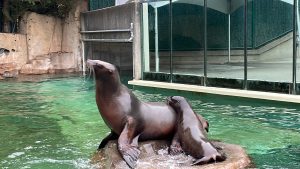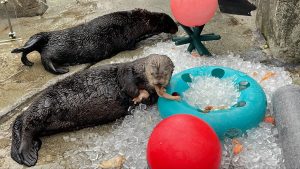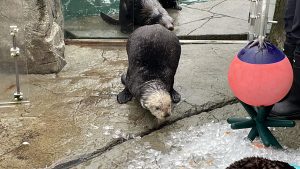Vancouver Aquarium animals contribute to species protection research
Posted November 10, 2022 10:07 pm.
Last Updated November 10, 2022 10:09 pm.
Animals at the Vancouver Aquarium are contributing to research that can help protect other ocean dwellers.
Learning more about the various species is something that the Marine Mammal Research Unit at the University of British Columbia (UBC) says is a key aspect in keeping animals healthy.
“Research into the health of individual animals is critical for ensuring their welfare, aids in conservation of wild populations, and provides insight into ecosystem health,” the unit says on its website.
Rouge, a 20-year-old Stellar sea lion who has spent most of her life at the aquarium, is doing her part in protecting others, including keeping the population up with the recent birth of her pup, Naota.

Stellar sea lions at the Vancouver Aquarium. (Angela Bower/CityNews)
“Rouge was part of a research study in collaboration with the University of British Columbia,” Jessica Debenedetto, an assistant curator of marine mammals at the aquarium, said.
A study published by the UBC research unit last year analyzes the effects of food restrictions on the growth rates of Stellar sea lions, and 12 sea lions from the aquarium were involved.
Debenedetto says animals like Rouge have played a key role in influencing and changing ocean policies that can help protect other animals living in the wild.

“Seeing an otter up close can create a special connection that can inspire people to take care of their environment around them, and make choices to help sea otters out in the ocean,” Jessica Debenedetto said. (Angela Bower/CityNews)
“Stellar sea lions were disappearing out in the ocean, and we didn’t really know why,” Debenedetto said. She explains the mammals “at the aquarium have really contributed to science and our understanding of Stellar sea lion’s needs, feeding needs, and metabolic needs.”
Debenedetto says researchers think climate change and overfishing has contributed to the decline of the Stellar sea lions, as it takes a large amount to keep them fed.
She adds some of the sea lions at the aquarium receive up to 50 pounds of food a day.
“There was possibly a change, a shift in the food that was available to them. So instead of a very high fat diet that would have give them the calories to exist out in the ocean, they were actually eating some lower calorie fish – so basically the equivalent if you were trying to survive off eating popcorn,” she added.

Otters are often rescued if the mother dies or abandons them, so they didn’t learn necessary survival skills like grooming and gathering food. (Angela Bower/CityNews)
The study says that the change in diet could affect the mammals physiologically, and affect their weights.
“Whether due to climate change or over-fishing, marine mammals are increasingly challenged to find adequate prey,” the unit added.
Rescue and Rehabilitation
In addition to learning more about different species, the aquarium also plays an active role in rescuing animals that can’t survive in the wild.
“Our rescue centre rehabilitates them for release back to our local waters, unless their injuries are too severe, or they were orphaned too young to fend for themselves. These find sanctuary at the aquarium and act as ambassadors for their kind,” the Vancouver Aquarium says on its website.
Eight sea otters currently make their home in the aquarium, and were rescued as pups.

The Vancouver Aquarium helps rescue sea otters that can’t survive on their own. (Angela Bower/CityNews)
The trainers explain the otters are often rescued if the mother dies or abandons them, so they didn’t learn necessary survival skills like grooming and gathering food.
Bebenedetto says the otters have, “very thick fur, and they depend on it to keep warm in our cold waters. So mum has to teach them how to groom that hair. They also have a high metabolism, they eat a quarter of their body weight every single day, and the mum has to teach them how to hunt, and collect that food.”
She says the rescue centre does a good job at taking care of the animals and teaching them how to survive, but it doesn’t replace the maternal coaching.
“They are never going to do as good as a job as a mother sea otter,” she explained.
“Seeing an otter up close can create a special connection that can inspire people to take care of their environment around them, and make choices to help sea otters out in the ocean,” she added.










